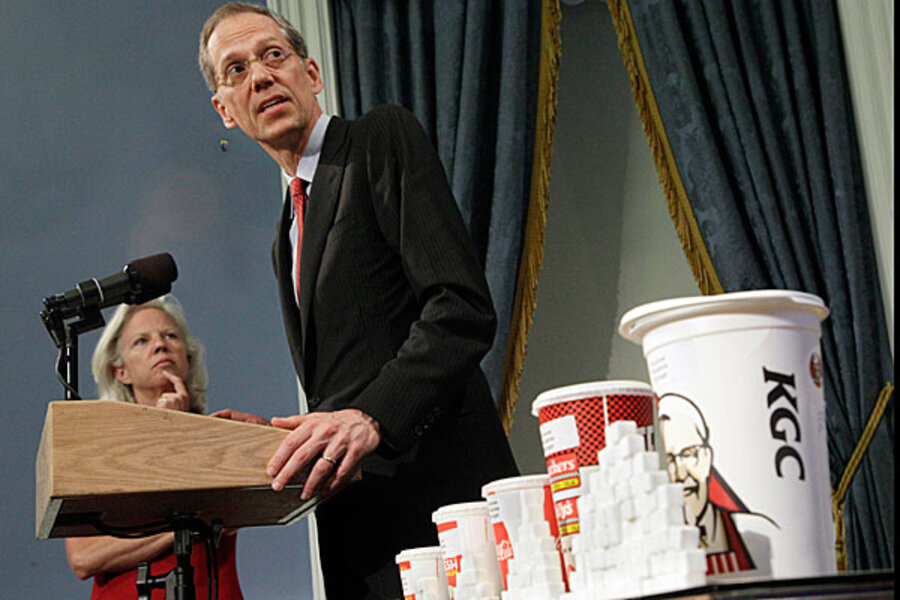Why Coke and McDonald's balk at big-drink ban in Big Apple
Loading...
| New York
Coca-Cola Co and McDonald's Corp slammed a proposed limit on soft drink sales in New York City that would turn a small McDonald's drink into the new large and could trigger a wave of similar restrictions aimed at curbing obesity.
"New Yorkers expect and deserve better than this. They can make their own choices about the beverages they purchase," Coca-Cola said in a statement on Thursday. Coke dominates the U.S. fountain drink market, and would likely be the most hurt.
On Wednesday, Bloomberg proposed amending the city's health code to ban the sale of soft drinks in cups larger than 16 ounces, a size equal to what McDonald's calls small. The chain's medium is 21 ounces, and its large is 32 ounces. Its kids' size is 12 ounces.
RECOMMENDED:10 weirdest fast foods in the world
"This raises the specter of this going to other cities as well," said Bernstein Research analyst Ali Dibadj. "These companies may have to start playing whack-a-mole if this gains momentum."
Heather Oldani, a spokeswoman for McDonald's, the world's biggest hamburger chain, said fighting obesity requires "a more collaborative and comprehensive approach".
"Public health issues cannot be effectively addressed through a narrowly focused and misguided ban," Oldani said. She declined to say how much of
McDonald's revenue comes from soft drinks, but Edward Jones analyst Jack Russo put it at around 5 percent.
The ban would apply to restaurants, mobile food carts, delicatessens and concessions at movie theaters, stadiums and arenas where sales of fountain drinks are common. It would not apply to convenience, grocery or drug stores, which mostly sell beverages in bottles and cans. That means 7-Eleven's Big Gulp would not be covered by the proposed ban.
The proposal, which would exclude diet and dairy-based coffee drinks, must be approved by the city's Board of Health.
"You can still be a beast. We're not keeping you from eating fattening foods or drinking 32-ounce bottles of full-sugar drinks," Mayor Bloomberg told the All Things Digital gathering in Rancho Palos Verdes, California on Thursday via video conference. "We are just telling you that this is detrimental to your health and making you understand that by portion size."
Bloomberg's assault on super-sized sodas opened a new front in the battle over how local governments regulate in the name of health what people eat and drink.
Public health advocates who have been fighting America's growing obesity problem say portion control is key to weight management.
"There's very strong scientific evidence that when people are served more they eat more, or in this case drink more," said Kelly Brownell, director of Yale University's Rudd Center for Food Policy and Obesity. Brownell applauded the proposal.
"My guess is this will affect enough people in a strong enough way to create a pretty significant public health benefit," he said.
Dr Pepper Snapple Group Inc did not return a call for comment. PepsiCo Inc referred questions to the New York City Beverage Association, which characterized the proposal as zealous and unlikely to work.
"The city is not going to address the obesity issue by attacking soda because soda is not driving the obesity rates," said Stefan Friedman, an association spokesman.
INDUSTRY CHALLENGE
Beverage companies have several arguments on which to base possible legal challenges, including that the ban would affect interstate commerce by impacting supplies such as soda syrup and cups, said Marc Scheineson, a former associate commissioner at the U.S. Food and Drug Administration and head of the food and drug practice at the Washington, D.C. law firm Allston & Bird.
That argument could be outweighed by the city's interest in public health, he said.
Other Bloomberg initiatives to improve public health, such as forbidding smoking in restaurants and requiring chain restaurants to post calorie counts, were the subject of lawsuits, but the city prevailed.
Regardless of whether it mounts any legal challenges, the industry is likely to spend a lot of money fighting the proposal like it has fought ongoing efforts to tax soft drinks, said Tom Pirko of Bevmark Consulting.
"This is a challenge to the basic premise of their business plan, all predicated on selling sweet drinks in the largest volumes possible," Pirko said.
"New York is a mega-market, but more importantly it is New York. It sets the pace. What happens in New York has a strong influence on the rest of the country," he said.
Coke controls 70 percent of the U.S . fountain drink market, according to Beverage Digest, followed by Pepsi with 19 percent and Dr Pepper Snapple with 11 percent.
Fountain business accounts for about 24 percent of the 9.3 billion cases of soda sold a year, Beverage Digest said, in a market worth $75.7 billion.
Coke has been boosting its fountain business with its new Freestyle dispenser that lets customers pick from over 100 flavor combinations. It is unclear how the Freestyle machine would work if the ban passed, since diet drinks are not constrained.
"To me, it puts a really big wrench in that," said Moody's analyst Linda Montag.
Like draught beers, fountain sodas are often more profitable for suppliers than those sold in bottles and cans because they require less packaging and often have higher markups. That means the ban could constrain profits as well as sales.
"Maybe you make up for it in pricing. You can't sell as much anymore, but you up your price a little bit so it doesn't impact the company all that much," Montag said.
The proposal is to be submitted on June 12 to the New York City Board of Health, which will have a three-month comment period before voting on it.
If approved, the ban would take effect six months later and be enforced by the city's restaurant inspectors. Restaurant owners would have nine months after adoption of the ban before facing fines of $200 for violations, Bloomberg said.







